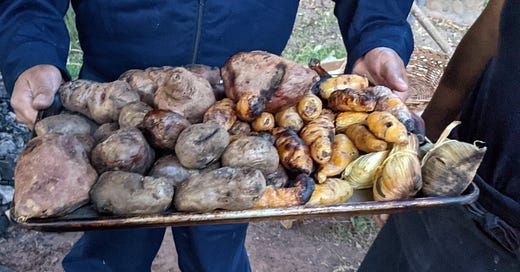Welcome to Thursday Things! If you enjoy this edition, please click the heart icon in the header or at the end of the post to let me know. You can also post a comment by clicking the dialogue bubble.
Potatoes of Peru! Image: Thursday Things
Potato Park!
Peru has the best potatoes in the world — and hundreds of varieties. It only makes sense because Peru is the homeland of the potato:
Angé explains that people around Lake Titicaca began cultivating tubers sometime between 8000 and 5000 BCE. And, even today, some highland people in the area still get as much as 70 percent of their calories from potatoes.
In the 20th century, Peruvian potato farmers cultivated large, uniform potatoes for the export market. But at home? Yeah, they eat the good stuff.
But when it comes to the potatoes they prefer to feed their own families, many still choose native varieties that can grow at higher altitudes. They also don’t require the fertilizers that commodity potatoes need to thrive, and they help preserve soil health.
These smaller, multi-colored potatoes are a storehouse of diverse genes and nutrients. And, from the perspective of the local farmers with whom Angé spoke, they’re so much more. Many of those interviewed enjoyed the experience of spending time with the plants in the field. They described potatoes grown at high altitudes as admirable for their ability to thrive in difficult conditions and as imbued with ancestral forces that reside high in the mountains.
Trust me, the ancestral forces make for awesome potatoes. Peru’s potato biodiversity is a world treasure and they know it. And that’s why Peru has a Potato Park:
To support the native potatoes and cultivate that respect, in 2002, five rural Quechua communities in the highlands joined with a local non-governmental organization to found the Parque de la Papa, or Potato Park. It covers about 35 square miles, encompassing the communities, which are home to 6,000 people. The park curates more than 1,000 varieties of native potatoes. There’s also a museum, a greenhouse, and a restaurant (potato-themed, of course). A team of eight Quechua technicians selected by their communities receive salaries to conduct experiments, study topics like climate change and food security, and keep the park running. They also work with outside scientists and other researchers—including Angé, who acknowledges them as collaborators in her work.
I have been to Peru and I have eaten their delicious potatoes and this makes me happy. Protect the potato at all costs!
The AI is your friend
Yes, I’m a little obsessed with OpenAI’s ChatGPT, and I’m not the only one. Even if you’re not interested in the AI chatbot, the AI chatbot is interested in you. And if your job has anything to do with writing, editing, or manipulating text or code, the chatbot is coming for you. Whether as friend or foe remains to be seen. Here is a point / counterpoint from Bleeping Computer:
OpenAI's new ChatGPT bot: 10 coolest things you can do with it
OpenAI's new ChatGPT bot: 10 dangerous things it's capable of
And here are a few other articles exploring implications of this technology:
OpenAI’s new chatbot ChatGPT could be a game-changer for businesses
“ChatGPT can be particularly useful if you’re running an e-commerce business and find it hard to keep up with all the text messages you’re getting,” he says. “If you’re not answering your messages on time, your customers might turn to a different seller. This way, you can interact with customers and engage them in conversation.”
Rahim adds this allows the company to also gather data on customer behaviour and preferences by analysing the way they interact with the AI without relying on human input. “This information can be used to improve the design of your website or product, target marketing campaigns better, or even create new products entirely based on feedback from your customers, all of which are essential factors to grow your business.”
Here’s What To Know About OpenAI’s ChatGPT—What It’s Disrupting And How To Use It
OpenAI released ChatGPT, its prototype AI chatbot that has gained a lot of traction among the public for its human-like, detailed answers to inquiries—like drafting a contract between an artist and producer and creating detailed code—and could revolutionize the way people use search engines by not just providing links for users to sift through, but by solving elaborate problems and answering intricate questions.
Read the articles for more. At least the AI can’t grow high altitude potatoes.
Penny for your thoughts
I’m one of those people who always stops to pick up a penny I find on the sidewalk, so I’ve got many, many chances to win!
You could have a penny worth $7K in your pocket — and not even know it
A coin connoisseur has made a convincing case for never giving away your change by revealing a 1983 Lincoln penny could be worth $7,000.
Blake Alma, the penny pundit behind the CoinHub TikTok account, is urging people to look through their loose change for a 1983 penny with no mint mark.
Mint marks are the letters on the face of the coin that indicate where the coin was made, like “P” for “Philadelphia.”
But that’s not the only thing to peep.
“Next, you’ll want to check the bottom of the coin’s other side to see if the ‘One cent’ wording has a ‘doubling effect,'” Alma explained.
The doubling of the letters occurs when the stamping machine accidentally imprints the coin twice in slightly different spots, creating a 3-D effect.
Check your change, Happy Subscribers, and you might be glad you did!
I think I see it! Photo by Acton Crawford on Unsplash
Thank you!
Please click the hearts, leave a comment, and use the share feature to send this issue to a friend who might enjoy it. See you next Thursday!




